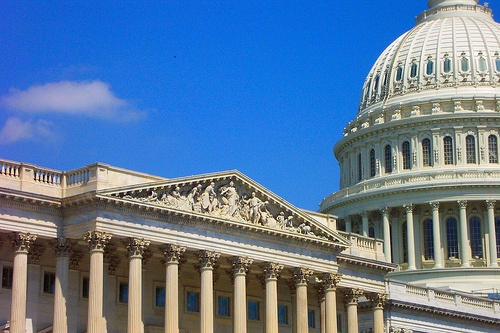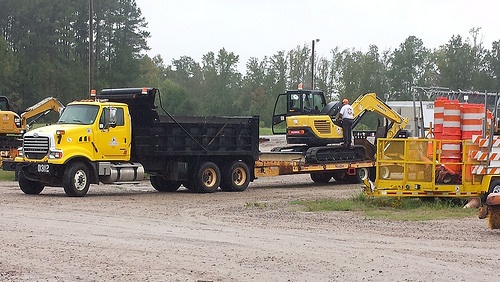Audit, Compliance and Risk Blog
Jon Elliott
Recent Posts
Tags: Business & Legal, Environmental risks, Environmental, EPA
Effective February 16, 2017, the Environmental Protection Agency (EPA) has issued a revised “National Pollutant Discharge Elimination System [NPDES] General Permit for Discharges from Construction Activities” (CGP).” This new 2017 CGP replaces EPA’s 2012 CGP, updating requirements for entities with construction sites that disturb more than 1 acre of land – readers should keep in mind that this covers individual projects, so that even if your organization isn’t a construction company or developer, a big expansion at your facility may be covered.
Read MoreTags: Health & Safety, Environmental risks, Environmental, EPA, Stormwater
Congressional Review Act Versus the Obama Administration’s Late Regulations
Posted by Jon Elliott on Tue, Mar 07, 2017
One mechanism seeing its first use in 16 years is the Congressional Review Act, which gives Congress the power to pass a joint resolution “disapproving” – repealing – a federal agency rulemaking. Each resolution requires Presidential approval, so as a practical matter it only works when a new president agrees with Congress to repeal one of his predecessor’s regulations. In 2001, President George W. Bush agreed with Congressional disapproval of an ergonomics standard adopted by the Occupational Safety and Health Administration (OSHA) during President Clinton’s governance in 2000. In contrast, President Obama vetoed five such resolutions while he was still president, blocking Congressional attempts to disapprove rules his own administration had adopted because Congressional leaders were unable to muster 2/3 supermajorities in both houses to override his vetoes. As of the end of February, three such resolutions have been passed and signed into law by President Trump.
What is the Congressional Review Act?
The Act was passed early in 1996, toward the end of President Clinton’s first term, and after the Republicans had gained majorities in both house of Congress from Democrats. Congressional leaders wanted the opportunity to review regulations and reject those they opposed, and were concerned that the Democratic Administration might enact so-called “midnight regulations” before the 1996 election. Accordingly:-
Federal agencies must submit a copy of each new rule to Congress, along with a concise general statement relating to the rule, including whether it is a major rule (i.e., likely to affect the national economy by more than $100 million annually); and its effective date.
-
Congress then has a total of 60 days in which both houses are in session, to review the rule and adopt a resolution of disapproval. Because a recess by either house stops the clock, 60 legislative days may cover many weeks – in 2016 any rule adopted on or after June 13 turned out to have fewer than 60 days remaining before the end of the 2015-2016 Congress.
-
When a rule is adopted with fewer than 60 days remaining, the 60-day clock restarts when the next Congress convenes, and is again measured based on days both houses are in session. During 2017, the House and Senate calendars presently indicate that the reconvened 2017-2018 Congress will have until May 17, 2017 to consider an Obama Administration rule adopted on or after June 13, 2016.
Which Resolutions Have Already Been Enacted During 2017?
As of the end of February, President Trump has signed legislation encompassing three resolutions of disapproval, vacating the following:-
Securities and Exchange Commission (SEC) Rule 13q-1, which would have required each “resource extraction issuer” to include in its annual reports information about any payment made by the issuer (or a subsidiary or entity under its control) to the U.S. federal government or any foreign government for the purpose of the commercial development of oil, natural gas, or minerals. This Rule implemented a statutory requirement enacted in 2010 by the Dodd-Frank Act.
-
Department of Interior (DOI) “Stream Protection Rule” (actually extensive rules in 30 CFR part 700 et seq.), which would have established extensive new and modified regulatory requirements intended to “protect water supplies, surface water and groundwater quality, streams, fish, wildlife, and related environmental values from the adverse impacts of surface coal mining operations.” This rule was adopted pursuant to the Surface Mining Control and Reclamation Act of 1977.
-
Social Security Administration (SSA) rules for providing the Attorney General with information about SSA beneficiaries who may be denied the right to buy and own guns, based on their mental health issues. These rules were adopted pursuant to the National Instant Criminal Background Check System (NICS) Improvement Amendments Act of 2007.
What Might Happen After a Rule is Disapproved?
A resolution of disapproval voids the targeted rule, sending the issue back to the adopting agency for more action. The Act prohibits the agency from reissuing the disapproved rule “in substantially the same form” – although few would expect an agency staffed by President Trump’s appointees to readopt a rule first approved by President Obama’s appointees. The Act provides no timeline for subsequent action, so SEC, DOI, and SSA (and other agencies that may experience similar disapprovals in the coming months) can move as quickly or slowly as their present priorities dictate.Congressional Review Act disapprovals have no direct effect on the underlying statute that provided authority and direction to the agency that adopted the rule. That requires separate legislation, approved by both houses of Congress and signed by the President.
Self-Assessment Checklist
Is the organization subject to a federal regulation adopted on or after June 13, 2016?-
SEC Resource Extraction Issuer reporting rule
-
DOI Stream Protection Rule
-
SSA NICS rule
-
Other rule
Where Can I Go For More Information?
-
Congressional Research Service “Insight” report (calculating 6/13/16 as cutoff for rules reviewable in 2017)
-
SEC’s Resource Extraction Issuer Rule
-
Rule (published in7/29/16 Federal Register)
-
Public Law 115-4, disapproving (signed 2/14/17)
-
-
DOI’s Stream Protection Rule
-
Rule (published in 12/20/16 Federal Register)
-
Public Law 115-5, disapproving (signed 2/14/17)
-
-
SSA’s NICS (eligibility for guns) rule
-
Rule (published in 12/19/16 Federal Register)
-
Public Law 115-8, disapproving (signed 2/28/17)
-
Specialty Technical Publishers (STP) provides a variety of single-law and multi-law services, intended to facilitate clients’ understanding of and compliance with requirements. These include:
About the Author
Jon Elliott is President of Touchstone Environmental and has been a major contributor to STP’s product range for over 25 years. He was involved in developing 13 existing products, including Environmental Compliance: A Simplified National Guide and The Complete Guide to Environmental Law.
Mr. Elliott has a diverse educational background. In addition to his Juris Doctor (University of California, Boalt Hall School of Law, 1981), he holds a Master of Public Policy (Goldman School of Public Policy [GSPP], UC Berkeley, 1980), and a Bachelor of Science in Mechanical Engineering (Princeton University, 1977).
Mr. Elliott is active in professional and community organizations. In addition, he is a past chairman of the Board of Directors of the GSPP Alumni Association, and past member of the Executive Committee of the State Bar of California's Environmental Law Section (including past chair of its Legislative Committee).
You may contact Mr. Elliott directly at: tei@ix.netcom.com
photo credit: Ania Mendrek Capitol Hill via photopin (license)
Read MoreEPA Revises Hazardous Waste Generator Requirements – Part 2 (Separate Summaries For Generator Categories)
Posted by Jon Elliott on Tue, Feb 21, 2017
In November, EPA published substantial regulatory revisions (which EPA entitles collectively as the Hazardous Waste Generator Improvements Rule). The revisions are scheduled to become effective on May 30, 2017. In Part 1 of this pair of blogs (click here), I summarized the principal revisions. In this Part 2 I re-compile the changes applicable to different categories of generators:
Read MoreTags: Environmental risks, Environmental, EPA, Hazcom
EPA Revises Hazardous Waste Generator Requirements – Part 1
Posted by Jon Elliott on Thu, Feb 16, 2017
In November, the U.S. Environmental Protection Agency (EPA) published substantial revisions to its hazardous waste regulations, which it entitles the “Hazardous Waste Generator Improvements Rule (HWGIR).” These include more than 60 changes to specific requirements, plus dozens of technical clarifications and corrections. Some requirements apply to nearly all generators, while others are targeted at one or more of three volume-based tiers. EPA has scheduled the revisions to take effect on May 30, 2017 – but it’s possible that some provisions will be reviewed and revised by the incoming Trump Administration before that date.
Read MoreTags: Environmental risks, Environmental, EHS, EPA, Hazcom
California Adopts Workplace Violence Prevention Requirements For Health Care Facilities
Posted by Jon Elliott on Thu, Feb 09, 2017
Health care and social service workers suffer workplace violence at much higher rates than in most other sectors, because of the higher risk from their patients and clients. In response, worker protection laws and regulations have begun to require workplace violence prevention in these sectors. The California Occupational Safety and Health Standards Board (OSHSB) just adopted a new regulation, implementing 2014 legislation that expands state requirements for hospital security plans, to include specified workplace violence prevention programs. Compliance begins in phases during 2017-2018, and will be administered by the Division of Occupational Safety and Health (Cal/OSHA)).
Read MoreTags: Employer Best Practices, Health & Safety, OSHA, Employee Rights, Workplace violence
OSHA Revises Walking, Climbing and Fall Protection Standards – Part 2 (Protective Systems and Training)
Posted by Jon Elliott on Tue, Jan 31, 2017
The Occupational Safety and Health Administration (OSHA) has issued massive revisions to its regulations requiring most employers (“General Industry”, in OSHA parlance), to protect employees from slip and fall hazards in most workplace contexts, including:
Read MoreTags: Employer Best Practices, Health & Safety, OSHA, Employee Rights, Environmental risks
OSHA Revises Walking, Climbing and Fall Protection Standards – Part I (Surfaces and Pathways Between Levels)
Posted by Jon Elliott on Mon, Jan 23, 2017
The Occupational Safety and Health Administration (OSHA) has issued massive revisions to its regulations requiring most employers (“General Industry”, in OSHA parlance), to protect employees from slip and fall hazards in most workplace contexts, including:
Read MoreTags: Employer Best Practices, Health & Safety, OSHA, Employee Rights
Since last November’s election, reporters, pundits and rumor-mongers have all worked overtime trying to predict President-elect Trump’s actions. I’ve resisted joining that chorus. Environmental issues received only a tiny portion of candidate Trump’s rhetorical attention (I presented a compilation before the election here), and he had said and done little about these issues since the election.
Read MoreTags: Environmental risks, Environmental, EPA
EEOC Issues Rule to Make Federal Government a Model Employer for People With Disabilities
Posted by Jon Elliott on Thu, Jan 12, 2017
Federal laws prohibit employers from basing employment decisions on a variety of factors, including “disability.” Private employers are subject to the Americans with Disabilities Act (ADA), while public agencies are subject to the Rehabilitation Act. Both laws are administered and enforced by the Equal Employment Opportunity Commission (EEOC), with states generally cooperating with EEOC or imposing similar requirements on state and local agencies. EEOC generally provides the same requirements and guidelines to both sets of employers, but there are differences.
Read More










